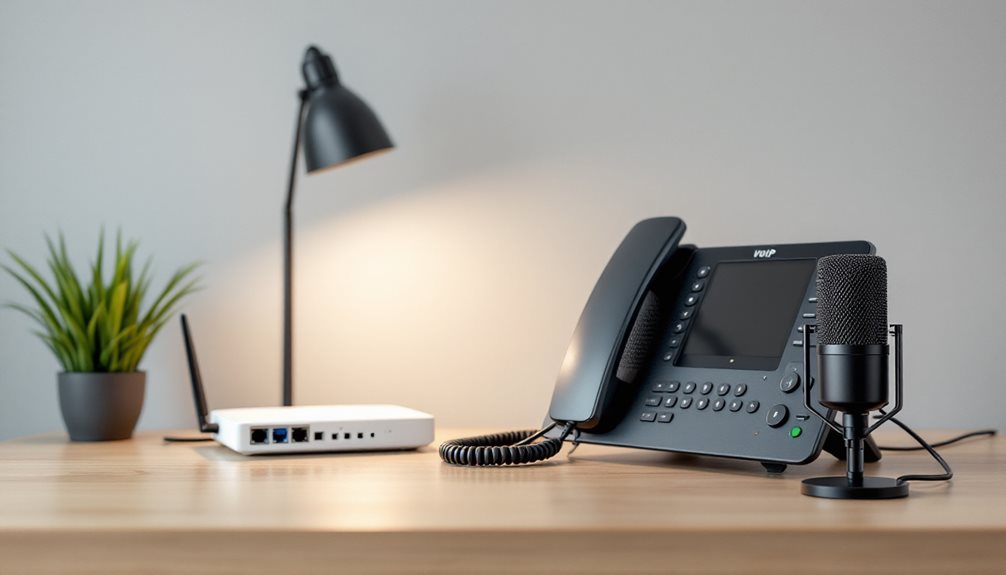VOIP call quality issues stem from packet loss, jitter, latency, and insufficient bandwidth. Businesses can enhance voice communications by conducting network assessments to determine adequate bandwidth requirements, implementing QoS settings that prioritize voice traffic, upgrading hardware such as IP phones with noise cancellation, and regularly monitoring system performance. Proper bandwidth calculation should account for concurrent calls during peak hours plus 20% overhead. These targeted improvements create clearer communications that directly impact customer satisfaction and employee productivity. The following strategies offer thorough solutions for persistent quality concerns.
Expert Highlights
- Implement Quality of Service (QoS) settings to prioritize voice traffic through packet tagging and traffic shaping.
- Calculate required bandwidth by multiplying concurrent calls by codec needs and adding 20% overhead.
- Invest in VOIP-specific hardware like IP phones with noise cancellation and QoS-capable routers.
- Regularly monitor network performance metrics including packet loss, jitter, and latency.
- Upgrade internet connection and network infrastructure to ensure sufficient capacity for peak call volumes.
Understanding Common VOIP Quality Issues and Their Causes

When users experience poor quality during VOIP calls, they often struggle to identify the root causes of their frustrating communication breakdowns. Common issues include packet loss (data fragments failing to reach their destination), jitter (irregular packet arrival), latency (delay in transmission), and insufficient bandwidth. These technical problems typically stem from network congestion, outdated equipment, improper QoS settings, or inadequate internet connections. Implementing proper network assessment before deploying your VoIP solution can help identify and address these issues proactively.
Assessing Your Network Infrastructure for Optimal VOIP Performance
Proper assessment of network infrastructure requires careful consideration of bandwidth requirements, latency thresholds, and hardware compatibility to guarantee peak VOIP performance. Organizations should conduct thorough bandwidth availability analysis to determine if current network capacity can handle peak call volumes without degradation. Examining network latency patterns, identifying potential bottlenecks, and confirming that routers, switches, and other network components meet VOIP-specific requirements will establish a solid foundation for reliable voice communications. With cloud PBX solutions, businesses can achieve 99.999% uptime through geo-redundant infrastructure that eliminates the need for on-premises hardware maintenance.
Bandwidth Availability Analysis
Before implementing any VOIP solution, conducting a thorough bandwidth availability analysis serves as the foundation for ensuring superior call quality across an organization’s network infrastructure. This assessment reveals existing limitations while providing clear pathways toward optimization, enabling teams to make data-driven decisions about necessary upgrades or reallocation of network resources.
| Bandwidth Requirement | Impact on Call Quality |
|---|---|
| 100 Kbps per call | Minimum baseline quality |
| 300 Kbps per call | Standard business quality |
| 500 Kbps per call | HD voice capability |
| 1+ Mbps per call | Video conferencing support |
Network Latency Examination
Network latency represents the fundamental challenge in delivering crystal-clear VOIP communications, often becoming the invisible barrier between acceptable and exceptional call quality. Measuring round-trip delay through ping tests reveals performance issues that cause choppy audio and disconnections. Implementing QoS policies, upgrading network equipment, and segregating VOIP traffic onto dedicated VLANs dramatically reduces latency, ensuring conversations flow naturally without frustrating delays.
Hardware Compatibility Check
Infrastructure compatibility forms the foundation of reliable VOIP implementation, yet organizations often struggle with unexpected hardware limitations that compromise call quality. Common issues include outdated routers lacking QoS features, incompatible headsets causing audio distortion, and insufficient processing power in session border controllers. Conducting a thorough inventory assessment identifies these potential bottlenecks before they manifest as dropped calls or voice distortion that frustrates clients and team members.
Bandwidth Requirements: How to Calculate What Your Business Needs
Determining how much bandwidth your VoIP system requires represents one of the most critical steps in ensuring call quality and system reliability. Calculating your specific needs involves a structured approach:
Bandwidth calculation: the foundation of every successful VoIP deployment and the key to pristine call quality.
- Count all concurrent calls your business typically handles during peak hours
- Multiply by codec requirements (G.711 needs ~85 Kbps per call)
- Add 20% overhead for network management traffic
- Factor in other applications sharing your network connection
Implementing Quality of Service (QoS) protocols will ensure your voice traffic receives priority over other network data for optimal clarity and performance.
Hardware Considerations: Choosing the Right Phones and Equipment

Once bandwidth requirements have been calculated, selecting appropriate hardware becomes the next priority for organizations seeking ideal VoIP performance. The right equipment directly impacts call clarity, reliability, and user satisfaction—critical factors for team cohesion and client communication. Most businesses can achieve seamless SIP Trunking integration with their existing PBX systems without requiring new hardware investments.
| Hardware Component | Selection Considerations |
|---|---|
| IP Phones | Noise cancellation, HD voice support |
| Headsets | Comfort, microphone quality |
| Routers | QoS capabilities, VoIP prioritization |
| Switches | PoE support, managed vs. unmanaged |
QoS Settings: Prioritizing Voice Traffic on Your Network
Quality of Service (QoS) settings serve as the critical foundation for maintaining clear, uninterrupted VoIP communications across busy networks. When properly configured, these settings guarantee your voice data receives priority access to bandwidth, preventing common issues like jitter and packet loss during high-traffic periods.
- Implement packet tagging (DSCP) to identify voice packets for preferential treatment
- Set up traffic shaping to manage bandwidth allocation during congestion
- Establish priority queuing to guarantee voice packets move ahead of less time-sensitive data
- Configure buffer settings to minimize latency while preventing voice distortion
Troubleshooting Jitter, Latency and Packet Loss in VOIP Systems

Nearly every VoIP system eventually encounters performance issues that manifest as deteriorated call quality, disconnections, or garbled audio. These problems typically stem from three key network factors: jitter (variation in packet arrival times), latency (delay between transmission and reception), and packet loss (data that never reaches its destination). Using network monitoring tools to identify these issues allows businesses to implement targeted solutions before they impact customer interactions.
Selecting the Right VOIP Service Provider for Your Business Needs
While traversing the crowded marketplace of VoIP service providers can overwhelm many business decision-makers, selecting the right partner ultimately determines whether an organization’s communication infrastructure will thrive or struggle.
Consider these critical evaluation criteria:
When selecting a VoIP provider, prioritize reliability, scalability, support responsiveness, and system compatibility.
- Service reliability with documented uptime percentages
- Scalability options that align with growth projections
- Technical support availability, including response times
- Compatibility with existing hardware and software systems
Implementing Regular Testing and Monitoring Protocols

Establishing robust testing and monitoring protocols forms the foundation of any successful VoIP implementation, enabling organizations to detect and address potential issues before they impact business operations. Teams should conduct weekly jitter and packet loss tests, implement automated monitoring for latency spikes, and regularly evaluate Mean Opinion Scores (MOS). These practices help maintain call clarity, prevent dropped connections, and guarantee consistent communication quality across the organization.
Frequently Asked Questions
Can VOIP Systems Integrate With Our Existing CRM Software?
Yes, VOIP systems commonly integrate with existing CRM platforms. Organizations can synchronize customer data, call records, and communications through APIs or pre-built connectors, streamlining workflows and enhancing customer service experiences.
How Do VOIP Systems Handle Emergency 911 Calls?
VOIP systems handle 911 calls through E911 services that transmit location data to emergency dispatchers. Businesses must register physical addresses for each phone to guarantee proper emergency response routing.
What Security Measures Protect VOIP Calls From Eavesdropping?
VoIP calls can be secured through encryption protocols like TLS/SRTP, secure network configurations, VPNs, regular security audits, and advanced authentication methods that prevent unauthorized access and potential eavesdropping attempts.
How Can Employees Use VOIP Effectively While Working Remotely?
Remote employees can optimize VOIP usage by ensuring stable internet connections, utilizing headsets, creating dedicated workspaces, testing equipment regularly, and familiarizing themselves with collaboration features their system offers.
Are There Regulatory Compliance Requirements for Business VOIP Systems?
Business VOIP systems must comply with regulations like HIPAA, GDPR, and local telecommunications laws. Organizations should implement call encryption, maintain call records, and guarantee proper data protection to meet these requirements.
Expert Final Thoughts
Optimizing VoIP call quality requires a systematic approach to network infrastructure, bandwidth allocation, and equipment selection. By implementing QoS settings, conducting regular testing, and partnering with reliable service providers, businesses can effectively minimize common issues like jitter, latency, and packet loss. The investment in proper VoIP optimization pays dividends through enhanced customer satisfaction, improved internal communication, and ultimately, stronger business relationships built on clear, uninterrupted conversations.






